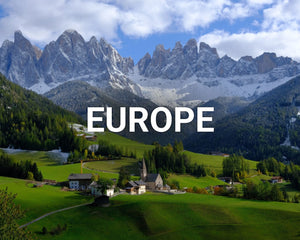
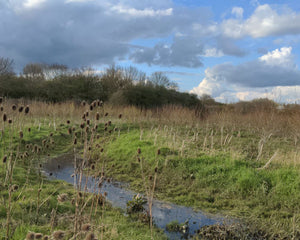
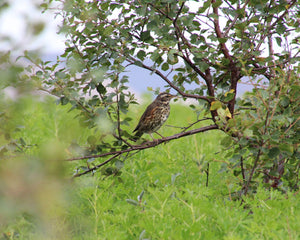
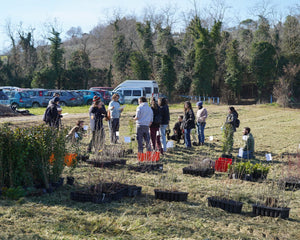
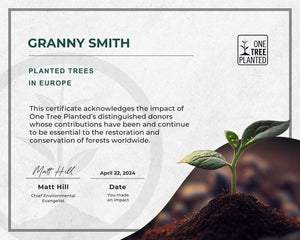
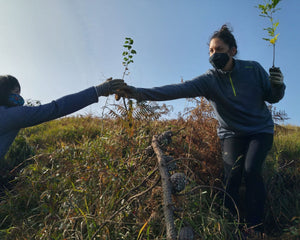
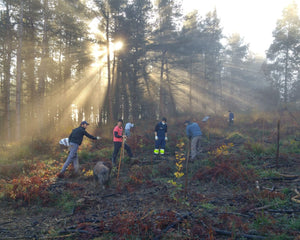
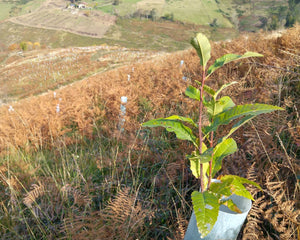
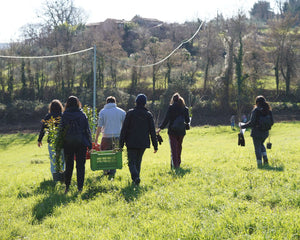
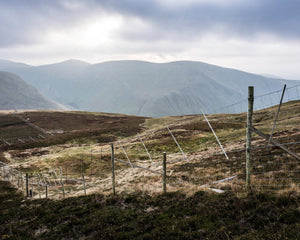
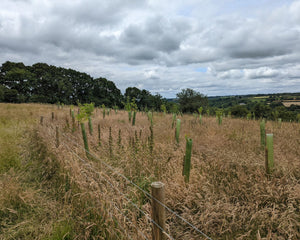
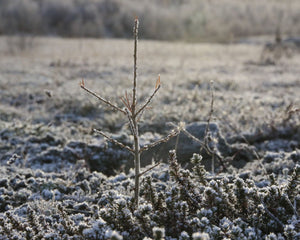
Europe
Together, Planting A Forest.
From the Black Forest of Brother’s Grimm lore to the historic Leiria Pine Forest, woodlands are woven into the fabric of Europe’s history. In the last 6,000 years, more than half of Europe’s forests have been lost. Our work in Europe focuses on re-establishing woodland, improving water and soil quality, and creating habitat for wildlife in areas that historically were forested. Learn more
With your help, we will:
- Restore native, historic woodlands
- Increase habitat connectivity
- Engage communities with restoration and environmental education
Looking to plant trees every month? Join The Grove.
Restore Forests in Europe
Making an Impact with One Tree Planted
-
Why We Do It
Europe’s forests have historically faced extreme deforestation pressure as a result of human expansion, conflict, the industrial revolution, and other factors. After WWII, over 120,000 miles of hedgerow were removed during intensive farming efforts. In more recent times, over the last decade, 1,000+ irreplaceable ancient woods have been threatened by development. Pests, diseases, and climate change only increase the pressure on already fragmented woodlands, and in the UK alone, millions of ash trees are threatened by the Chalara ash dieback.
Our reforestation projects in Europe are impacted by a range of factors that increase complexity, including habitat fragmentation, grazing, settlement, and higher regional costs. However, public will and governmental commitments make now a very impactful time for reforestation efforts in Europe.
-
How We Do It
As Europe experiences increasing climate change impacts such as record-high temperatures, forest fires in Greece, flooding in Italy, and more, reforestation is more important than ever. Our Europe projects are planting trees to increase climate change resilience, improve public access to green spaces, improve habitat connectivity, and stabilize and enrich soils.
Through thoughtful reforestation initiatives, we can ensure a greener future for European forests and communities. Restoring native woodlands is an important step towards climate regulation, protecting access to clean water, encouraging native wildlife, and more. Our carefully planned projects are designed to have cascading benefits, including natural, social, financial, and inspirational returns.
-
Showcase Your Impact
A personalized tree certificate (see gallery) to say thanks for your donation. We’ll also send you a report on the Europe project that your donation was allocated to, so you can better understand your trees' impact on the environment and communities.
-
What We Plant
Every tree we plant will have an impact on the surrounding ecosystem, and must be selected with great care. We work with our planting partners to ensure the species we select will provide the intended benefits for wildlife and communities.
Our Europe projects focus on planting trees to increase habitat connectivity, improve climate change resilience, and restore habitat for native biodiversity. A typical planting might include species such as alder, oak, ash, fir, pine, spruce, and larch. Species are carefully selected with a range of factors in mind, including the specific region, climate, and purpose of the planting.

Quality
Projects

Community &
Social Benefits

Project
Reporting

Wildlife
Protection

Climate Change
Resilience
About One Tree Planted
Our Model
We believe in complete transparency regarding how your donation dollars are utilized. We work together with our partners to determine how we can best support them within our reforestation model. Each project has a budget that covers specific primary costs. To learn more about how our funding works, visit the Our Model page.

Global Reforestation
We work with local planting partners in more than eighty countries, across diverse ecosystems, to fund large-scale, high-impact projects.

Established Non-Profit
One Tree Planted is a 501(c)(3) non-profit environmental charity that makes it easy for individuals, businesses, and foundations to get involved and make an impact around the world.

Positive Impact
Every tree planted with One Tree Planted makes a positive impact. Together, we can restore forests, create habitat for biodiversity, and make a positive social impact.
Keep Track of Your Impact
Project Reports
Every One Tree Planted project begins with a detailed proposal from a local planting partner, which details where, why, and how the trees will be planted. After planting wraps up, our Monitoring, Reporting and Verification Team works closely with our reforestation partners to map and monitor their growing trees. This allows us to analyze the impact the trees will have on overall forest health, biodiversity, and surrounding communities.
We take donor impact reporting seriously, and require our reforestation partners to track and report specific metrics for every project that is completed. Click on the button below to view a planting report from a recent reforestation project.

Our Project Locations
Reforestation Map
Planting trees in Europe will help increase public woodland access and promote climate change resilience, impacting nature and communities with every donation. Click on the reforestation map to discover a selection of our Europe projects, and the impact they will have for generations to come!

Why Plant Trees?
Six Pillars of Reforestation
Forests provide jobs to over 1.6 billion people, absorb harmful carbon from the atmosphere, and provide key ingredients for 25% of all medicines. Have you ever taken an Aspirin? It comes from the bark of a tree! At One Tree Planted, we focus on the 6 Pillars of Reforestation. These pillars are the foundation of why planting trees is such a significant action to take.
Air
Trees help to clean the air we breathe. Through their leaves and bark, they absorb harmful pollutants and release clean oxygen for us to breathe. In urban environments and other ecosystems, trees absorb pollutant gases such as nitrogen oxide, ozone, and carbon monoxide, and sweep up particles such as dust and smoke. Increasing levels of carbon dioxide caused by deforestation and fossil fuel combustion trap heat in the atmosphere.
Water
Trees play a key role in capturing rainwater and reducing the risk of natural disasters such as floods and landslides. Their intricate root systems act as natural filters, removing pollutants and slowing down the water’s absorption into the soil. This process prevents harmful waterslide erosion and reduces the risk of over-saturation and flooding. According to the UN Food and Agriculture Association, a mature evergreen tree can intercept more than 15,000 litres of water every year.
Biodiversity
A single tree can be home to hundreds of species of insects, fungi, mosses, mammals, and plants. Depending on the type of food and shelter they need, different forest animals require different types of habitat. Without trees, forest creatures would have nowhere to call home.
Social Impact
From arborists to loggers and researchers, the job opportunities provided by the forestry industry are endless. We don’t just rely on trees for work, though. Sustainable tree farming provides timber to build homes and shelters, and wood to burn for cooking and heating. Food-producing trees provide fruit, nuts, berries, and leaves for consumption by both humans and animals, and pack a powerful nutritional punch.
Health
Did you know that hospital patients with rooms overlooking trees recover faster than those without the same view? It’s impossible to ignore that feeling of elation you get while walking through a calm, quiet forest. Trees help reduce stress and anxiety, and allow us to reconnect with nature. In addition, shade provided by canopy cover helps to protect our skin from the ever-increasing harshness of the sun.
Climate
Trees help cool the planet by absorbing and storing harmful greenhouse gases such as carbon dioxide into their trunks, branches, and leaves — and releasing oxygen back into the atmosphere. In cities, trees can reduce ambient temperatures by up to 8° Celsius. With more than 50% of the world’s population living in cities — a number expected to increase to 66% by the year 2050 — urban trees are more important than ever.
Case Studies
Our Highlighted Projects
One Tree Planted has planted trees in six global regions: North America, Latin America, Africa, Asia, Europe, and The Pacific. Every reforestation project has a unique impact on forests, communities, biodiversity, and the environment. Check out the incredible impact some of our past projects have made!
Nationwide Community Planting
Northern Ireland
Read more
This project helped to support biodiversity by planting different types of tree cover at varying densities. By creating pockets of diverse habitat in and around the trees, this project supported species ranging from bugs and insects to small mammals and amphibians, larger mammals, and birds.
Trees help to protect soil by creating physical barriers and traps for eroded soils that are on the move. They also improve soil fertility by increasing organic matter through leaf litter and light brush, which is full of nutrients brought up by tree roots and then dropped onto the ground to rot into the soil. This helped to reduce the need for artificial fertilizers.
Throughout this project, many groups from disadvantaged communities and schools, religious groups, disabled groups were included. The aim was to bring the communities along on the journey of planting and managing their trees so that they felt a sense of ownership, and understood the benefits to them and the local environment. This fosters a sense of connection and promotes long-term project success.
Dragon's Nest Forest
Iceland
Read more
The planting area for this project was located on degraded former grazing land with low-growing and largely non-continuous vegetation. The main goals of restoring this land were carbon sequestration and soil conservation. A mixed species forest restored habitat for many species, providing enriched biodiversity everything from fungi and other soil organisms to arthropods, birds and mammals. Enough openings were left for shade-intolerant plants and open-ground birds to remain in the area, besides which the surrounding landscape will remain treeless. The planted area has moderate stream fluctuations, creating ideal conditions for freshwater organisms — including many insects, small crustaceans, and fish.
The restored area is accessible to people from the local village. Over time, footpaths and other outdoor recreation facilities will be developed. Local people will benefit from jobs in fence maintenance and tree planting.
Reviving the Carpathians
Romania
Read more
The Carpathia project not only replanted clear-cuts from the past with native species, it also recreated the natural forest composition, adapted to projected future climate change impacts. Carpathia has so far used eleven different tree species, and reintroduced the European Yew to the southern Fagaras Mountains. Further ecological benefits include the restoration of the forest floor on former tractor tracks, where erosion after every snowmelt or after every heavy summer rain has caused not only the loss of topsoil, but also the input of mud into the river systems with negative consequences for aquatic life.
Employment at the tree nurseries, tree planting, and site preparation and maintenance was offered to the local communities. A big portion of the daily labor was made up of families who were economically marginalized, but through this project, they had a stable income source during the project.




















